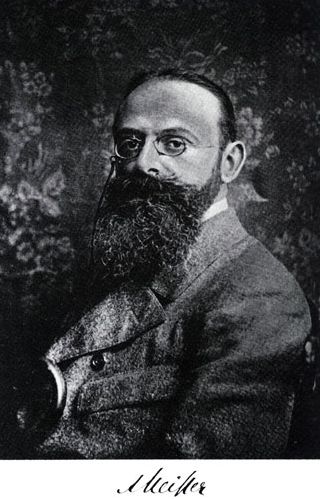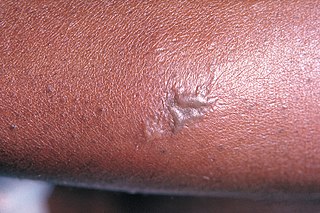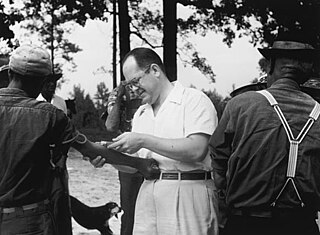Related Research Articles

Syphilis is a sexually transmitted infection caused by the bacterium Treponema pallidum subspecies pallidum. The signs and symptoms of syphilis vary depending in which of the four stages it presents. The primary stage classically presents with a single chancre though there may be multiple sores. In secondary syphilis, a diffuse rash occurs, which frequently involves the palms of the hands and soles of the feet. There may also be sores in the mouth or vagina. In latent syphilis, which can last for years, there are few or no symptoms. In tertiary syphilis, there are gummas, neurological problems, or heart symptoms. Syphilis has been known as "the great imitator" as it may cause symptoms similar to many other diseases.

Neisseria gonorrhoeae, also known as gonococcus (singular) or gonococci (plural), is a species of Gram-negative diplococci bacteria isolated by Albert Neisser in 1879. It causes the sexually transmitted genitourinary infection gonorrhea as well as other forms of gonococcal disease including disseminated gonococcemia, septic arthritis, and gonococcal ophthalmia neonatorum.

The Tuskegee Study of Untreated Syphilis in the Negro Male was a study conducted between 1932 and 1972 by the United States Public Health Service (PHS) and the Centers for Disease Control and Prevention (CDC) on a group of nearly 400 African American men with syphilis. The purpose of the study was to observe the effects of the disease when untreated, though by the end of the study medical advancements meant it was entirely treatable. The men were not informed of the nature of the experiment, and more than 100 died as a result.

Albert Ludwig Sigesmund Neisser was a German physician who discovered the causative agent (pathogen) of gonorrhea, a strain of bacteria that was named in his honour.

Thomas Parran was an American physician and Public Health Service officer. He was appointed the sixth Surgeon General of the United States from 1936 to 1948, and oversaw the notorious Tuskegee syphilis experiment and Guatemala syphilis experiment.

The Federal Correctional Complex, Terre Haute is a United States federal prison complex for male inmates in Indiana; much of the complex grounds is in Terre Haute, though portions are in unincorporated Vigo County. It is operated by the Federal Bureau of Prisons, a division of the United States Department of Justice, and consists of two facilities:
Venereology is a branch of medicine that is concerned with the study and treatment of sexually transmitted diseases (STDs). The name derives from Roman goddess Venus, associated with love, beauty and fertility. A physician specializing in venereology is called a venereologist. In many areas of the world, the specialty is usually combined with dermatology.
The Stateville Penitentiary malaria study was a controlled but ethically questionable study of the effects of malaria on prisoners of Stateville Penitentiary near Joliet, Illinois, in the 1940s, conducted by the Department of Medicine at the University of Chicago in conjunction with the United States Army and the State Department. The Stateville experiment was viewed as coercive because it offered shortened sentences to participants. The Green report was written in 1945 about it by Andrew Conway Ivy, used in Nuremberg Medical Trial, which affected the Nuremberg Code, and used to discuss how medical experimentation on prisoners should be carried out.

Gonorrhoea or gonorrhea, colloquially known as the clap, is a sexually transmitted infection (STI) caused by the bacterium Neisseria gonorrhoeae. Infection may involve the genitals, mouth, or rectum. Infected men may experience pain or burning with urination, discharge from the penis, or testicular pain. Infected women may experience burning with urination, vaginal discharge, vaginal bleeding between periods, or pelvic pain. Complications in women include pelvic inflammatory disease and in men include inflammation of the epididymis. Many of those infected, however, have no symptoms. If untreated, gonorrhea can spread to joints or heart valves.

A sexually transmitted infection (STI), also referred to as a sexually transmitted disease (STD) and the older term venereal disease (VD), is an infection that is spread by sexual activity, especially vaginal intercourse, anal sex, oral sex, or sometimes manual sex. STIs often do not initially cause symptoms, which results in a risk of passing the infection on to others. Symptoms and signs of STIs may include vaginal discharge, penile discharge, ulcers on or around the genitals, and pelvic pain. Some STIs can cause infertility.

Nazi human experimentation was a series of medical experiments on prisoners by Nazi Germany in its concentration camps mainly between 1942 and 1945. There were 15,754 documented victims, of various nationalities and age groups, although the true number is believed to be more extensive. Many survived, with a quarter of documented victims being killed. Survivors generally experienced severe permanent injuries.

Numerous experiments which are performed on human test subjects in the United States are considered unethical, because they are performed without the knowledge or informed consent of the test subjects. Such tests have been performed throughout American history, but some of them are ongoing. The experiments include the exposure of humans to many chemical and biological weapons, human radiation experiments, injections of toxic and radioactive chemicals, surgical experiments, interrogation and torture experiments, tests which involve mind-altering substances, and a wide variety of other experiments. Many of these tests are performed on children, the sick, and mentally disabled individuals, often under the guise of "medical treatment". In many of the studies, a large portion of the subjects were poor, racial minorities, or prisoners.

The Guatemala syphilis experiments were United States-led human experiments conducted in Guatemala from 1946 to 1948. The experiments were led by physician John Charles Cutler, who also participated in the late stages of the Tuskegee syphilis experiment. Doctors infected 1,300 people, including at least 600 soldiers and people from various impoverished groups with syphilis, gonorrhea, and chancroid, without the informed consent of the subjects. Only 700 of them received treatment. In total, 5,500 people were involved in all research experiments, of whom 83 died by the end of 1953, though it is unknown whether or not the injections were responsible for all these deaths. Serology studies continued through 1953 involving the same vulnerable populations in addition to children from state-run schools, an orphanage, and rural towns. However, the intentional infection of patients ended with the original study.

John Charles Cutler was a senior surgeon, and the acting chief of the venereal disease program in the United States Public Health Service. He is known for leading several controversial and unethical human experiments of syphilis, done under the auspices of the Public Health Service. He willfully spread syphilis and gonorrhea to unwitting patients including soldiers, prisoners, adults with leprosy, mental patients and orphan children as young as nine in the Guatemala syphilis experiments. He also conducted the Tuskegee syphilis experiments, in which African American men, not informed of the nature of the experiment, were deliberately infected with syphilis.

The first recorded outbreak of syphilis in Europe occurred in 1494/1495 in Naples, Italy, during a French invasion. Because it was spread geographically by French troops returning from that campaign, the disease was known as "French disease", and it was not until 1530 that the term "syphilis" was first applied by the Italian physician and poet Girolamo Fracastoro. The causative organism, Treponema pallidum, was first identified by Fritz Schaudinn and Erich Hoffmann in 1905 at the Charité Clinic in Berlin. The first effective treatment, Salvarsan, was developed in 1910 by Sahachiro Hata in the laboratory of Paul Ehrlich. It was followed by the introduction of penicillin in 1943.
Various organizations have created guidelines for human subject research for various kinds of research involving human subjects and for various situations.
The outbreaks of sexually transmitted infections in World War II brought interest in sex education to the public and the government. During the late 1930s and early 1940s, military maneuvers increased worldwide and sexual hygiene and conduct became major problems for the troops. Soldiers and sailors on assignment overseas were often lonely, had time to spare, got homesick, or were just looking for female companionship. This resulted in many men having multiple sex partners, and as a result, became a major health concern. During the Great War, venereal diseases (V.D.) had caused the United States Army to lose 18,000 servicemen per day. Although by 1944, this number had been reduced 30-fold, there were still around 606 servicemen incapacitated daily. This drop in numbers was partly because of the Army's effort to raise awareness about the dangers faced by servicemen through poor sexual hygiene, and also because of the important developments in medicine. In late 1943, a case of gonorrhea required a hospital treatment of 30 days, and curing syphilis remained a 6-month ordeal. By mid-1944, the average case of gonorrhea was reduced to 5 days, and in many cases the patient remained on duty while being treated.

John Friend Mahoney was an American physician best known as a pioneer in the treatment of syphilis with penicillin. He won the 1946 Lasker Award.
Unethical human experimentation is human experimentation that violates the principles of medical ethics. Such practices have included denying patients the right to informed consent, using pseudoscientific frameworks such as race science, and torturing people under the guise of research. Around World War II, Imperial Japan and Nazi Germany carried out brutal experiments on prisoners and civilians through groups like Unit 731 or individuals like Josef Mengele; the Nuremberg Code was developed after the war in response to the Nazi experiments. Countries have carried out brutal experiments on marginalized populations. Examples include American abuses during Project MKUltra and the Tuskegee syphilis experiments, and the mistreatment of indigenous populations in Canada and Australia. The Declaration of Helsinki, developed by the World Medical Association (WMA), is widely regarded as the cornerstone document on human research ethics.
Beginning in the early 20th century, a number of U.S. states passed laws mandating medical examinations for one or both parties before marriage. The most common requirement was a blood test for syphilis, though other diseases such as gonorrhea and rubella were sometimes also targeted. If a partner tested positive, they would generally be required to undergo treatment before they could receive a marriage license.
References
- 1 2 3 4 5 6 7 8 9 10 11 12 13 14 15 16 17 18 19 20 21 22 "Ethically Impossible" STD Research in Guatemala from 1946 to 1948 (PDF). Washington, D.C.: Presidential Commission for the Study of Bioethical Issues. September 2011.
- 1 2 3 4 5 6 7 8 9 10 11 12 13 14 Marks, Harry M. (2000). The progress of experiment: Science and therapeutic reform in the United States 1900–1990. Cambridge University Press. p. 105. ISBN 9780521785617.
- ↑ Di Cicco, Camillo (2014). History of syphilis: a night with Venus, a lifetime with Mercury. CreateSpace Independent Publishing Platform. p. 54. ISBN 9781500139650.